Full text
PDF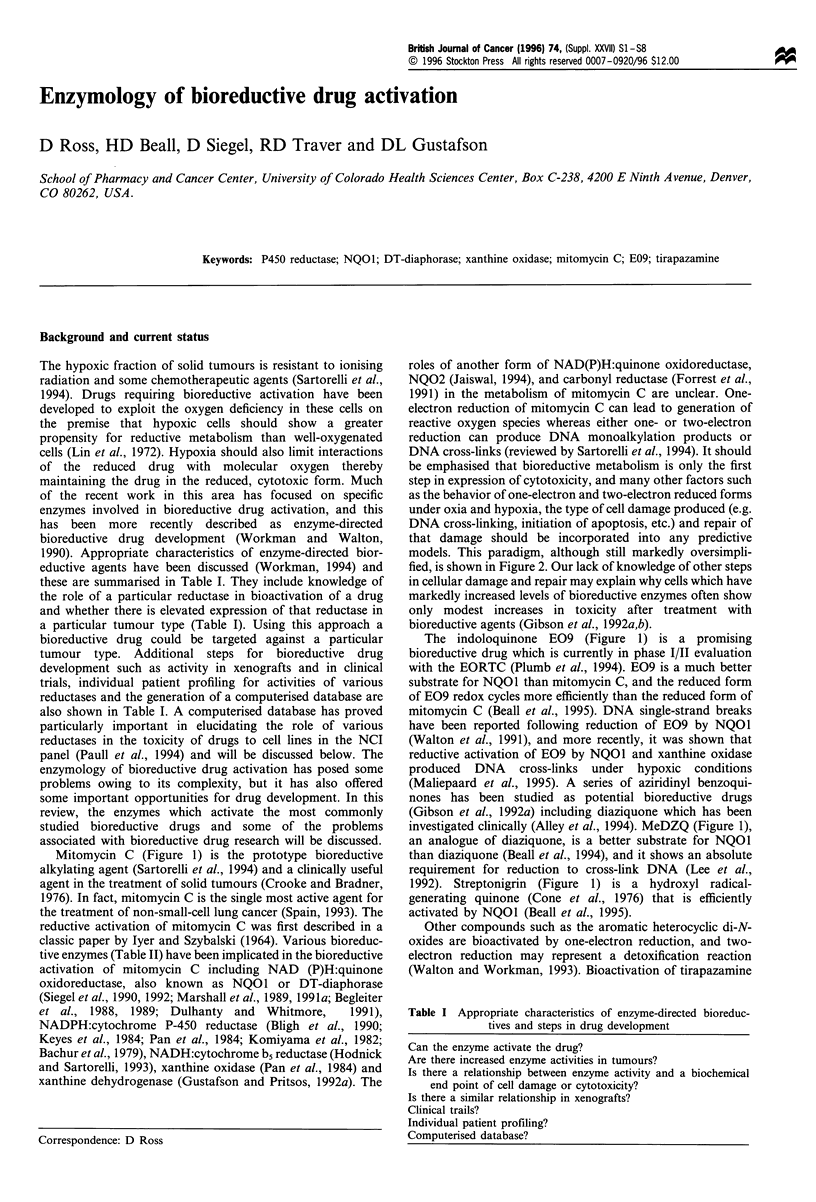
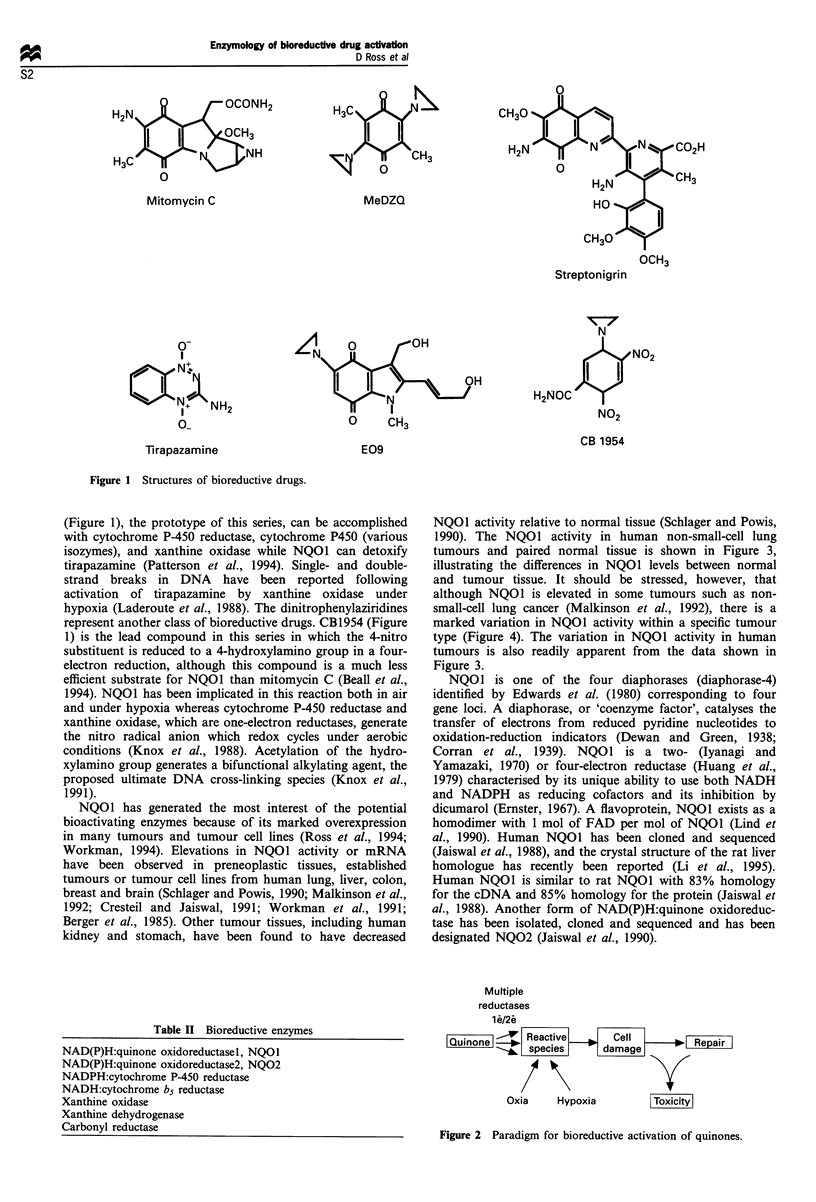
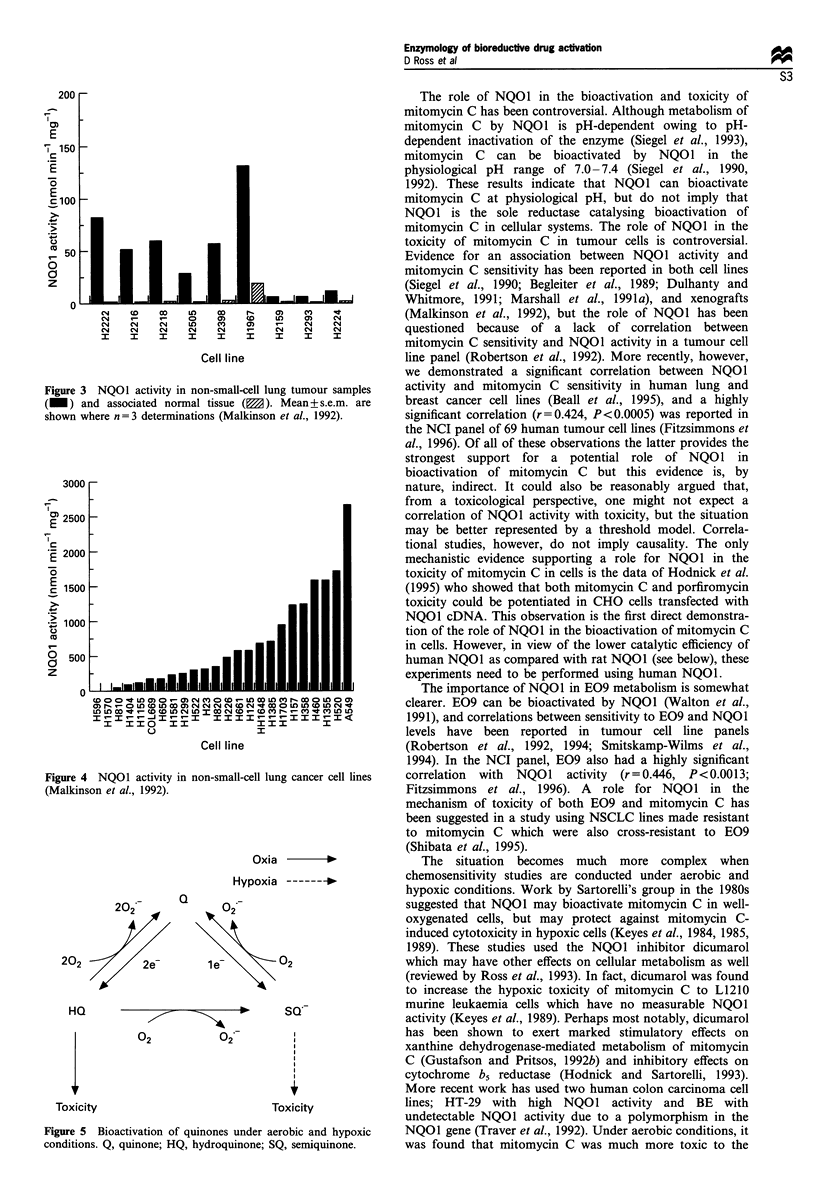
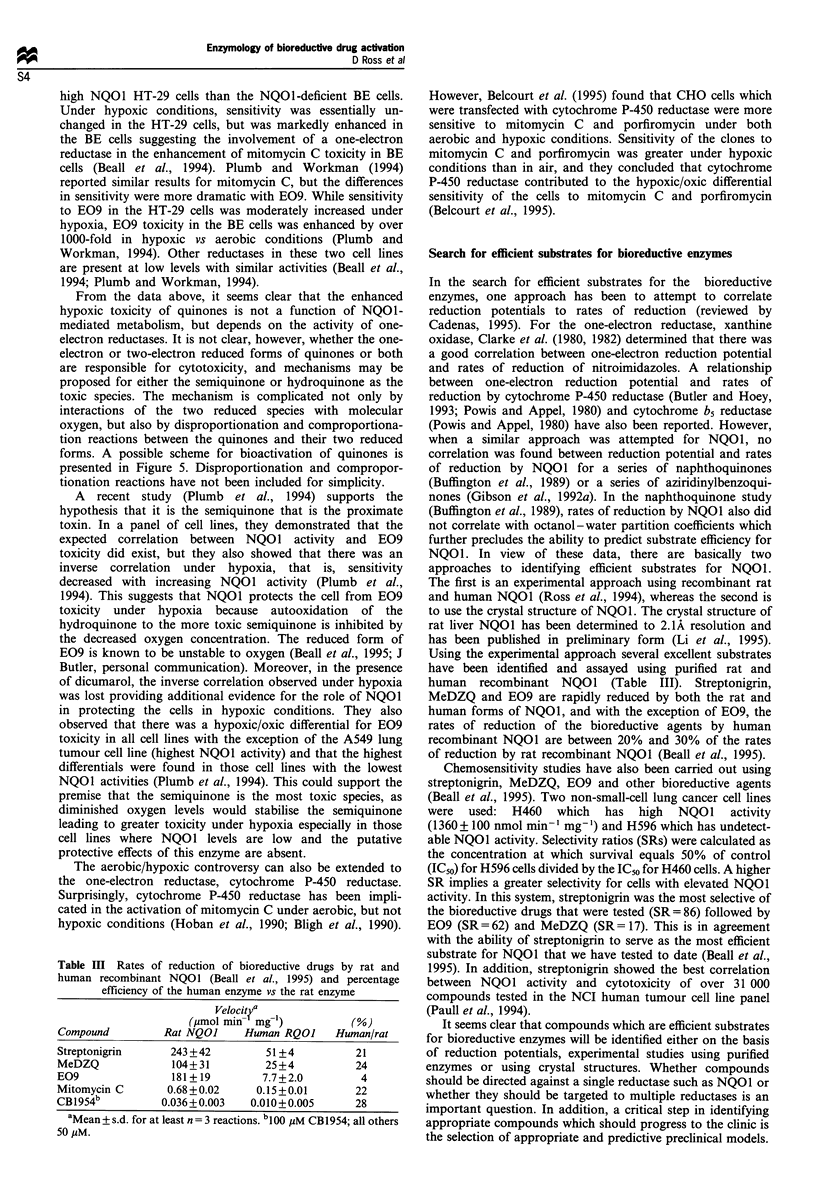
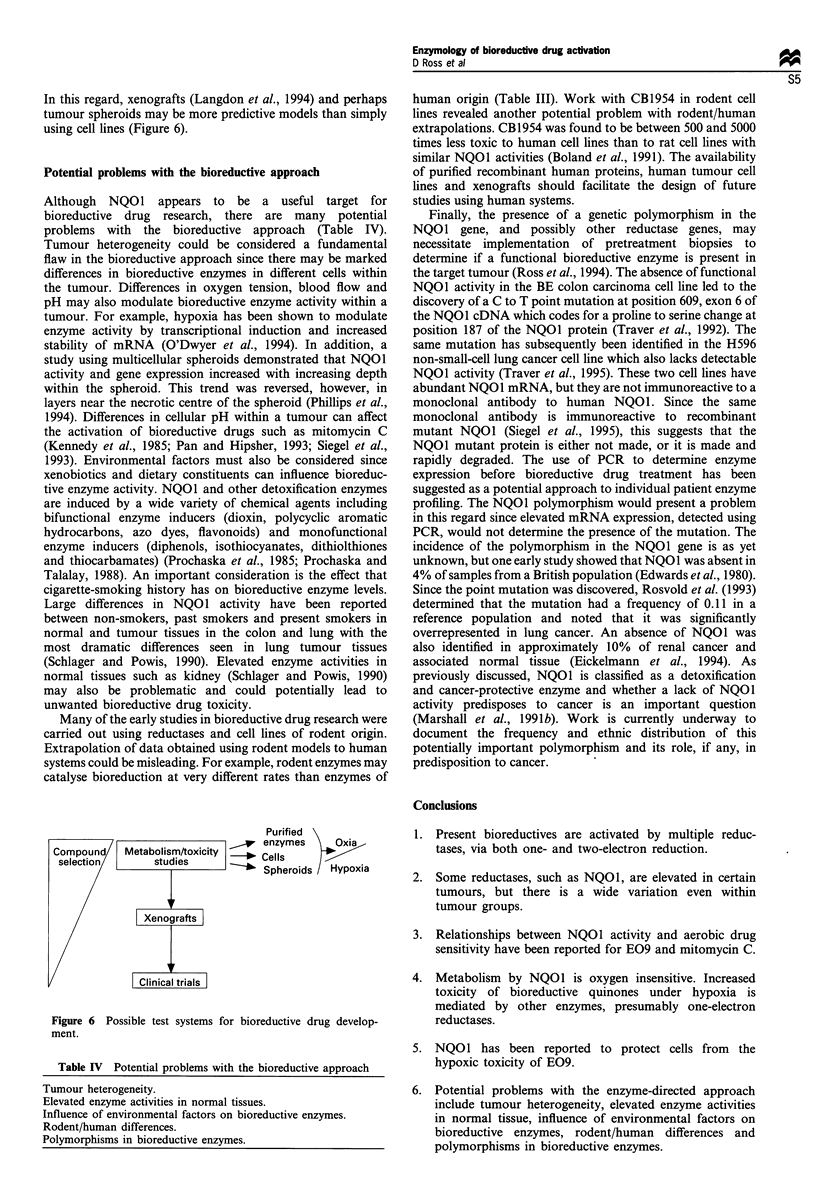
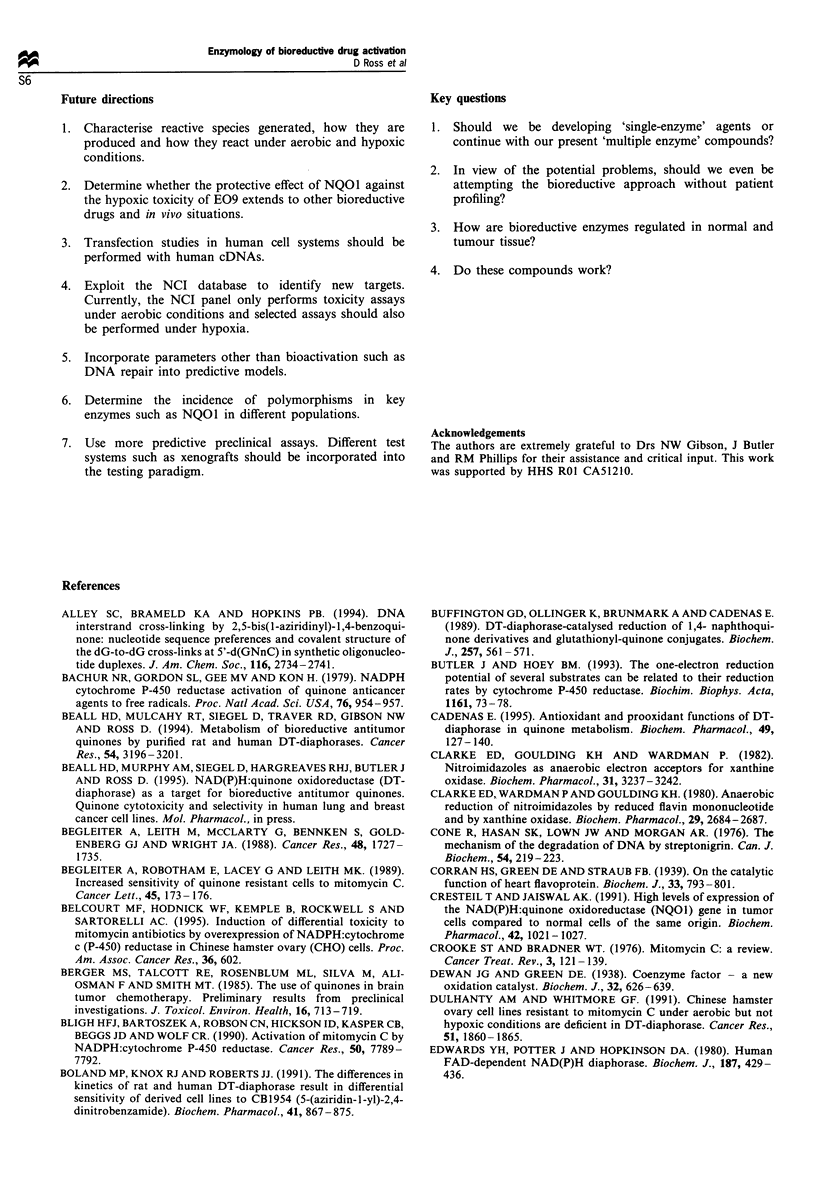
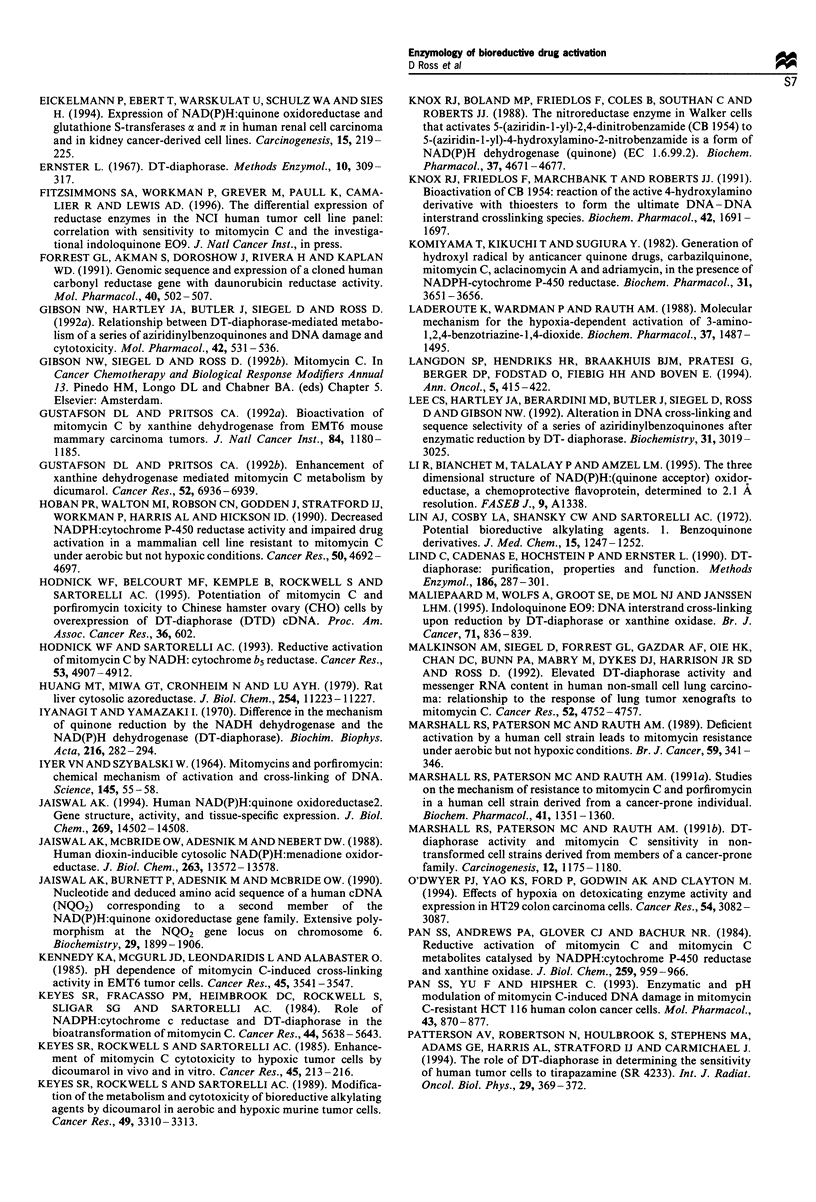
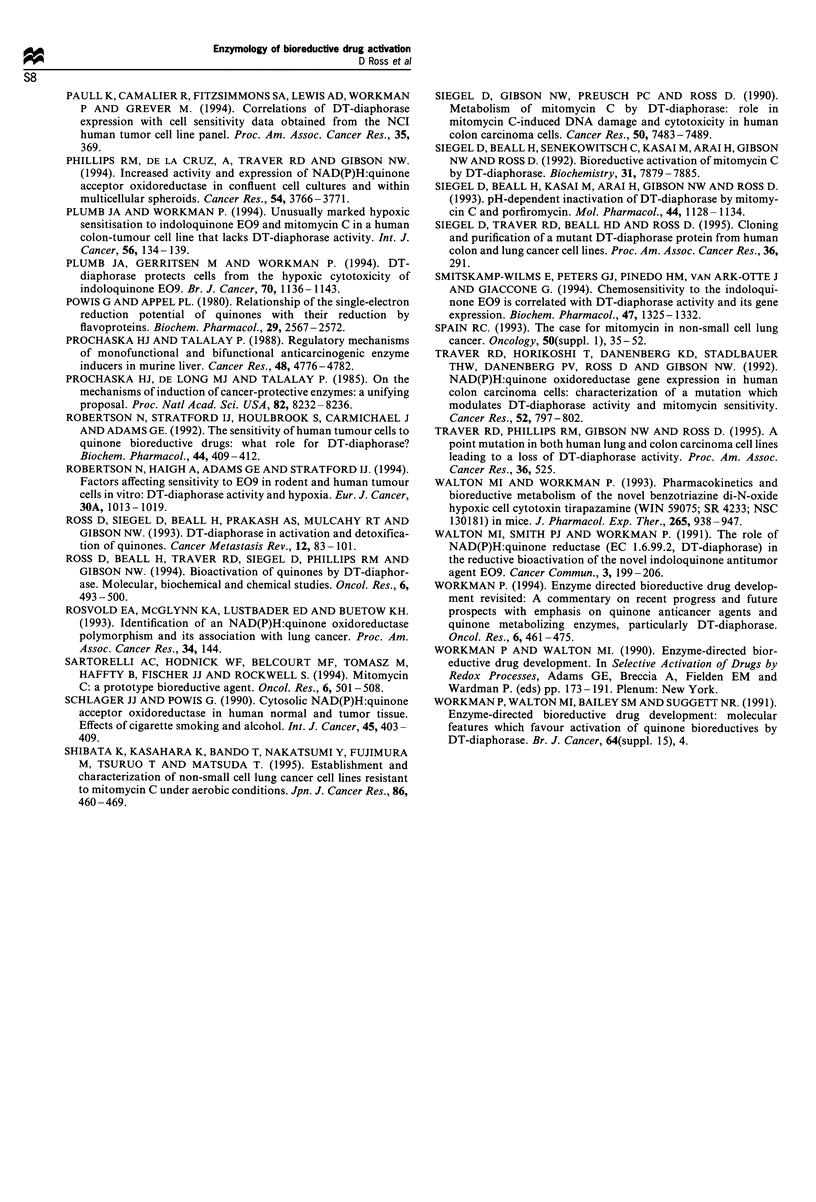
Selected References
These references are in PubMed. This may not be the complete list of references from this article.
- Bachur N. R., Gordon S. L., Gee M. V., Kon H. NADPH cytochrome P-450 reductase activation of quinone anticancer agents to free radicals. Proc Natl Acad Sci U S A. 1979 Feb;76(2):954–957. doi: 10.1073/pnas.76.2.954. [DOI] [PMC free article] [PubMed] [Google Scholar]
- Beall H. D., Mulcahy R. T., Siegel D., Traver R. D., Gibson N. W., Ross D. Metabolism of bioreductive antitumor compounds by purified rat and human DT-diaphorases. Cancer Res. 1994 Jun 15;54(12):3196–3201. [PubMed] [Google Scholar]
- Begleiter A., Leith M. K., McClarty G., Beenken S., Goldenberg G. J., Wright J. A. Characterization of L5178Y murine lymphoblasts resistant to quinone antitumor agents. Cancer Res. 1988 Apr 1;48(7):1727–1735. [PubMed] [Google Scholar]
- Begleiter A., Robotham E., Lacey G., Leith M. K. Increased sensitivity of quinone resistant cells to mitomycin C. Cancer Lett. 1989 Jun;45(3):173–176. doi: 10.1016/0304-3835(89)90073-6. [DOI] [PubMed] [Google Scholar]
- Berger M. S., Talcott R. E., Rosenblum M. L., Silva M., AliOsman F., Smith M. T. Use of quinones in brain-tumor therapy: preliminary results of preclinical laboratory investigations. J Toxicol Environ Health. 1985;16(5):713–719. doi: 10.1080/15287398509530781. [DOI] [PubMed] [Google Scholar]
- Bligh H. F., Bartoszek A., Robson C. N., Hickson I. D., Kasper C. B., Beggs J. D., Wolf C. R. Activation of mitomycin C by NADPH:cytochrome P-450 reductase. Cancer Res. 1990 Dec 15;50(24):7789–7792. [PubMed] [Google Scholar]
- Boland M. P., Knox R. J., Roberts J. J. The differences in kinetics of rat and human DT diaphorase result in a differential sensitivity of derived cell lines to CB 1954 (5-(aziridin-1-yl)-2,4-dinitrobenzamide) 1991 Mar 15-Apr 1Biochem Pharmacol. 41(6-7):867–875. doi: 10.1016/0006-2952(91)90190-g. [DOI] [PubMed] [Google Scholar]
- Buffinton G. D., Ollinger K., Brunmark A., Cadenas E. DT-diaphorase-catalysed reduction of 1,4-naphthoquinone derivatives and glutathionyl-quinone conjugates. Effect of substituents on autoxidation rates. Biochem J. 1989 Jan 15;257(2):561–571. doi: 10.1042/bj2570561. [DOI] [PMC free article] [PubMed] [Google Scholar]
- Butler J., Hoey B. M. The one-electron reduction potential of several substrates can be related to their reduction rates by cytochrome P-450 reductase. Biochim Biophys Acta. 1993 Jan 15;1161(1):73–78. doi: 10.1016/0167-4838(93)90198-z. [DOI] [PubMed] [Google Scholar]
- Cadenas E. Antioxidant and prooxidant functions of DT-diaphorase in quinone metabolism. Biochem Pharmacol. 1995 Jan 18;49(2):127–140. doi: 10.1016/s0006-2952(94)00333-5. [DOI] [PubMed] [Google Scholar]
- Clarke E. D., Goulding K. H., Wardman P. Nitroimidazoles as anaerobic electron acceptors for xanthine oxidase. Biochem Pharmacol. 1982 Oct 15;31(20):3237–3242. doi: 10.1016/0006-2952(82)90556-1. [DOI] [PubMed] [Google Scholar]
- Clarke E. D., Wardman P., Goulding K. H. Anaerobic reduction of nitroimidazoles by reduced flavin mononucleotide and by xanthine oxidase. Biochem Pharmacol. 1980 Oct 1;29(19):2684–2687. doi: 10.1016/0006-2952(80)90087-8. [DOI] [PubMed] [Google Scholar]
- Cone R., Hasan S. K., Lown J. W., Morgan A. R. The mechanism of the degradation of DNA by streptonigrin. Can J Biochem. 1976 Mar;54(3):219–223. doi: 10.1139/o76-034. [DOI] [PubMed] [Google Scholar]
- Corran H. S., Green D. E., Straub F. B. On the catalytic function of heart flavoprotein. Biochem J. 1939 May;33(5):793–801. doi: 10.1042/bj0330793. [DOI] [PMC free article] [PubMed] [Google Scholar]
- Cresteil T., Jaiswal A. K. High levels of expression of the NAD(P)H:quinone oxidoreductase (NQO1) gene in tumor cells compared to normal cells of the same origin. Biochem Pharmacol. 1991 Aug 8;42(5):1021–1027. doi: 10.1016/0006-2952(91)90284-c. [DOI] [PubMed] [Google Scholar]
- Crooke S. T., Bradner W. T. Mitomycin C: a review. Cancer Treat Rev. 1976 Sep;3(3):121–139. doi: 10.1016/s0305-7372(76)80019-9. [DOI] [PubMed] [Google Scholar]
- Dewan J. G., Green D. E. Coenzyme factor-a new oxidation catalyst. Biochem J. 1938 Mar;32(3):626–639. doi: 10.1042/bj0320626. [DOI] [PMC free article] [PubMed] [Google Scholar]
- Dulhanty A. M., Whitmore G. F. Chinese hamster ovary cell lines resistant to mitomycin C under aerobic but not hypoxic conditions are deficient in DT-diaphorase. Cancer Res. 1991 Apr 1;51(7):1860–1865. [PubMed] [Google Scholar]
- Edwards Y. H., Potter J., Hopkinson D. A. Human FAD-dependent NAD(P)H diaphorase. Biochem J. 1980 May 1;187(2):429–436. doi: 10.1042/bj1870429. [DOI] [PMC free article] [PubMed] [Google Scholar]
- Eickelmann P., Ebert T., Warskulat U., Schulz W. A., Sies H. Expression of NAD(P)H:quinone oxidoreductase and glutathione S-transferases alpha and pi in human renal cell carcinoma and in kidney cancer-derived cell lines. Carcinogenesis. 1994 Feb;15(2):219–225. doi: 10.1093/carcin/15.2.219. [DOI] [PubMed] [Google Scholar]
- Forrest G. L., Akman S., Doroshow J., Rivera H., Kaplan W. D. Genomic sequence and expression of a cloned human carbonyl reductase gene with daunorubicin reductase activity. Mol Pharmacol. 1991 Oct;40(4):502–507. [PubMed] [Google Scholar]
- Gibson N. W., Hartley J. A., Butler J., Siegel D., Ross D. Relationship between DT-diaphorase-mediated metabolism of a series of aziridinylbenzoquinones and DNA damage and cytotoxicity. Mol Pharmacol. 1992 Sep;42(3):531–536. [PubMed] [Google Scholar]
- Gustafson D. L., Pritsos C. A. Bioactivation of mitomycin C by xanthine dehydrogenase from EMT6 mouse mammary carcinoma tumors. J Natl Cancer Inst. 1992 Aug 5;84(15):1180–1185. doi: 10.1093/jnci/84.15.1180. [DOI] [PubMed] [Google Scholar]
- Gustafson D. L., Pritsos C. A. Enhancement of xanthine dehydrogenase mediated mitomycin C metabolism by dicumarol. Cancer Res. 1992 Dec 15;52(24):6936–6939. [PubMed] [Google Scholar]
- Hoban P. R., Walton M. I., Robson C. N., Godden J., Stratford I. J., Workman P., Harris A. L., Hickson I. D. Decreased NADPH:cytochrome P-450 reductase activity and impaired drug activation in a mammalian cell line resistant to mitomycin C under aerobic but not hypoxic conditions. Cancer Res. 1990 Aug 1;50(15):4692–4697. [PubMed] [Google Scholar]
- Hodnick W. F., Sartorelli A. C. Reductive activation of mitomycin C by NADH:cytochrome b5 reductase. Cancer Res. 1993 Oct 15;53(20):4907–4912. [PubMed] [Google Scholar]
- Huang M. T., Miwa G. T., Cronheim N., Lu A. Y. Rat liver cytosolic azoreductase. Electron transport properties and the mechanism of dicumarol inhibition of the purified enzyme. J Biol Chem. 1979 Nov 25;254(22):11223–11227. [PubMed] [Google Scholar]
- IYER V. N., SZYBALSKI W. MITOMYCINS AND PORFIROMYCIN: CHEMICAL MECHANISM OF ACTIVATION AND CROSS-LINKING OF DNA. Science. 1964 Jul 3;145(3627):55–58. doi: 10.1126/science.145.3627.55. [DOI] [PubMed] [Google Scholar]
- Iyanagi T., Yamazaki I. One-electron-transfer reactions in biochemical systems. V. Difference in the mechanism of quinone reduction by the NADH dehydrogenase and the NAD(P)H dehydrogenase (DT-diaphorase). Biochim Biophys Acta. 1970 Sep 1;216(2):282–294. doi: 10.1016/0005-2728(70)90220-3. [DOI] [PubMed] [Google Scholar]
- Jaiswal A. K., Burnett P., Adesnik M., McBride O. W. Nucleotide and deduced amino acid sequence of a human cDNA (NQO2) corresponding to a second member of the NAD(P)H:quinone oxidoreductase gene family. Extensive polymorphism at the NQO2 gene locus on chromosome 6. Biochemistry. 1990 Feb 20;29(7):1899–1906. doi: 10.1021/bi00459a034. [DOI] [PubMed] [Google Scholar]
- Jaiswal A. K. Human NAD(P)H:quinone oxidoreductase2. Gene structure, activity, and tissue-specific expression. J Biol Chem. 1994 May 20;269(20):14502–14508. [PubMed] [Google Scholar]
- Jaiswal A. K., McBride O. W., Adesnik M., Nebert D. W. Human dioxin-inducible cytosolic NAD(P)H:menadione oxidoreductase. cDNA sequence and localization of gene to chromosome 16. J Biol Chem. 1988 Sep 25;263(27):13572–13578. [PubMed] [Google Scholar]
- Kennedy K. A., McGurl J. D., Leondaridis L., Alabaster O. pH dependence of mitomycin C-induced cross-linking activity in EMT6 tumor cells. Cancer Res. 1985 Aug;45(8):3541–3547. [PubMed] [Google Scholar]
- Keyes S. R., Fracasso P. M., Heimbrook D. C., Rockwell S., Sligar S. G., Sartorelli A. C. Role of NADPH:cytochrome c reductase and DT-diaphorase in the biotransformation of mitomycin C1. Cancer Res. 1984 Dec;44(12 Pt 1):5638–5643. [PubMed] [Google Scholar]
- Keyes S. R., Rockwell S., Sartorelli A. C. Enhancement of mitomycin C cytotoxicity to hypoxic tumor cells by dicoumarol in vivo and in vitro. Cancer Res. 1985 Jan;45(1):213–216. [PubMed] [Google Scholar]
- Keyes S. R., Rockwell S., Sartorelli A. C. Modification of the metabolism and cytotoxicity of bioreductive alkylating agents by dicoumarol in aerobic and hypoxic murine tumor cells. Cancer Res. 1989 Jun 15;49(12):3310–3313. [PubMed] [Google Scholar]
- Knox R. J., Boland M. P., Friedlos F., Coles B., Southan C., Roberts J. J. The nitroreductase enzyme in Walker cells that activates 5-(aziridin-1-yl)-2,4-dinitrobenzamide (CB 1954) to 5-(aziridin-1-yl)-4-hydroxylamino-2-nitrobenzamide is a form of NAD(P)H dehydrogenase (quinone) (EC 1.6.99.2). Biochem Pharmacol. 1988 Dec 15;37(24):4671–4677. doi: 10.1016/0006-2952(88)90336-x. [DOI] [PubMed] [Google Scholar]
- Knox R. J., Friedlos F., Marchbank T., Roberts J. J. Bioactivation of CB 1954: reaction of the active 4-hydroxylamino derivative with thioesters to form the ultimate DNA-DNA interstrand crosslinking species. Biochem Pharmacol. 1991 Oct 9;42(9):1691–1697. doi: 10.1016/0006-2952(91)90503-w. [DOI] [PubMed] [Google Scholar]
- Komiyama T., Kikuchi T., Sugiura Y. Generation of hydroxyl radical by anticancer quinone drugs, carbazilquinone, mitomycin C, aclacinomycin A and adriamycin, in the presence of NADPH-cytochrome P-450 reductase. Biochem Pharmacol. 1982 Nov 15;31(22):3651–3656. doi: 10.1016/0006-2952(82)90590-1. [DOI] [PubMed] [Google Scholar]
- Laderoute K., Wardman P., Rauth A. M. Molecular mechanisms for the hypoxia-dependent activation of 3-amino-1,2,4-benzotriazine-1,4-dioxide (SR 4233). Biochem Pharmacol. 1988 Apr 15;37(8):1487–1495. doi: 10.1016/0006-2952(88)90010-x. [DOI] [PubMed] [Google Scholar]
- Langdon S. P., Hendriks H. R., Braakhuis B. J., Pratesi G., Berger D. P., Fodstad O., Fiebig H. H., Boven E. Preclinical phase II studies in human tumor xenografts: a European multicenter follow-up study. Ann Oncol. 1994 May;5(5):415–422. doi: 10.1093/oxfordjournals.annonc.a058872. [DOI] [PubMed] [Google Scholar]
- Lee C. S., Hartley J. A., Berardini M. D., Butler J., Siegel D., Ross D., Gibson N. W. Alteration in DNA cross-linking and sequence selectivity of a series of aziridinylbenzoquinones after enzymatic reduction by DT-diaphorase. Biochemistry. 1992 Mar 24;31(11):3019–3025. doi: 10.1021/bi00126a025. [DOI] [PubMed] [Google Scholar]
- Lin A. J., Cosby L. A., Shansky C. W., Sartorelli A. C. Potential bioreductive alkylating agents. 1. Benzoquinone derivatives. J Med Chem. 1972 Dec;15(12):1247–1252. doi: 10.1021/jm00282a011. [DOI] [PubMed] [Google Scholar]
- Lind C., Cadenas E., Hochstein P., Ernster L. DT-diaphorase: purification, properties, and function. Methods Enzymol. 1990;186:287–301. doi: 10.1016/0076-6879(90)86122-c. [DOI] [PubMed] [Google Scholar]
- Maliepaard M., Wolfs A., Groot S. E., de Mol N. J., Janssen L. H. Indoloquinone EO9: DNA interstrand cross-linking upon reduction by DT-diaphorase or xanthine oxidase. Br J Cancer. 1995 Apr;71(4):836–839. doi: 10.1038/bjc.1995.161. [DOI] [PMC free article] [PubMed] [Google Scholar]
- Malkinson A. M., Siegel D., Forrest G. L., Gazdar A. F., Oie H. K., Chan D. C., Bunn P. A., Mabry M., Dykes D. J., Harrison S. D. Elevated DT-diaphorase activity and messenger RNA content in human non-small cell lung carcinoma: relationship to the response of lung tumor xenografts to mitomycin Cł. Cancer Res. 1992 Sep 1;52(17):4752–4757. [PubMed] [Google Scholar]
- Marshall R. S., Paterson M. C., Rauth A. M. DT-diaphorase activity and mitomycin C sensitivity in non-transformed cell strains derived from members of a cancer-prone family. Carcinogenesis. 1991 Jul;12(7):1175–1180. doi: 10.1093/carcin/12.7.1175. [DOI] [PubMed] [Google Scholar]
- Marshall R. S., Paterson M. C., Rauth A. M. Deficient activation by a human cell strain leads to mitomycin resistance under aerobic but not hypoxic conditions. Br J Cancer. 1989 Mar;59(3):341–346. doi: 10.1038/bjc.1989.67. [DOI] [PMC free article] [PubMed] [Google Scholar]
- Marshall R. S., Paterson M. C., Rauth A. M. Studies on the mechanism of resistance to mitomycin C and porfiromycin in a human cell strain derived from a cancer-prone individual. Biochem Pharmacol. 1991 May 1;41(9):1351–1360. doi: 10.1016/0006-2952(91)90108-h. [DOI] [PubMed] [Google Scholar]
- O'Dwyer P. J., Yao K. S., Ford P., Godwin A. K., Clayton M. Effects of hypoxia on detoxicating enzyme activity and expression in HT29 colon adenocarcinoma cells. Cancer Res. 1994 Jun 15;54(12):3082–3087. [PubMed] [Google Scholar]
- Pan S. S., Andrews P. A., Glover C. J., Bachur N. R. Reductive activation of mitomycin C and mitomycin C metabolites catalyzed by NADPH-cytochrome P-450 reductase and xanthine oxidase. J Biol Chem. 1984 Jan 25;259(2):959–966. [PubMed] [Google Scholar]
- Pan S. S., Yu F., Hipsher C. Enzymatic and pH modulation of mitomycin C-induced DNA damage in mitomycin C-resistant HCT 116 human colon cancer cells. Mol Pharmacol. 1993 Jun;43(6):870–877. [PubMed] [Google Scholar]
- Patterson A. V., Robertson N., Houlbrook S., Stephens M. A., Adams G. E., Harris A. L., Stratford I. J., Carmichael J. The role of DT-diaphorase in determining the sensitivity of human tumor cells to tirapazamine (SR 4233). Int J Radiat Oncol Biol Phys. 1994 May 15;29(2):369–372. doi: 10.1016/0360-3016(94)90291-7. [DOI] [PubMed] [Google Scholar]
- Phillips R. M., de la Cruz A., Traver R. D., Gibson N. W. Increased activity and expression of NAD(P)H:quinone acceptor oxidoreductase in confluent cell cultures and within multicellular spheroids. Cancer Res. 1994 Jul 15;54(14):3766–3771. [PubMed] [Google Scholar]
- Plumb J. A., Gerritsen M., Workman P. DT-diaphorase protects cells from the hypoxic cytotoxicity of indoloquinone EO9. Br J Cancer. 1994 Dec;70(6):1136–1143. doi: 10.1038/bjc.1994.461. [DOI] [PMC free article] [PubMed] [Google Scholar]
- Plumb J. A., Workman P. Unusually marked hypoxic sensitization to indoloquinone EO9 and mitomycin C in a human colon-tumour cell line that lacks DT-diaphorase activity. Int J Cancer. 1994 Jan 2;56(1):134–139. doi: 10.1002/ijc.2910560124. [DOI] [PubMed] [Google Scholar]
- Powis G., Appel P. L. Relationship of the single-electron reduction potential of quinones to their reduction by flavoproteins. Biochem Pharmacol. 1980 Oct 1;29(19):2567–2572. doi: 10.1016/0006-2952(80)90068-4. [DOI] [PubMed] [Google Scholar]
- Prochaska H. J., De Long M. J., Talalay P. On the mechanisms of induction of cancer-protective enzymes: a unifying proposal. Proc Natl Acad Sci U S A. 1985 Dec;82(23):8232–8236. doi: 10.1073/pnas.82.23.8232. [DOI] [PMC free article] [PubMed] [Google Scholar]
- Prochaska H. J., Talalay P. Regulatory mechanisms of monofunctional and bifunctional anticarcinogenic enzyme inducers in murine liver. Cancer Res. 1988 Sep 1;48(17):4776–4782. [PubMed] [Google Scholar]
- Robertson N., Haigh A., Adams G. E., Stratford I. J. Factors affecting sensitivity to EO9 in rodent and human tumour cells in vitro: DT-diaphorase activity and hypoxia. Eur J Cancer. 1994;30A(7):1013–1019. doi: 10.1016/0959-8049(94)90134-1. [DOI] [PubMed] [Google Scholar]
- Robertson N., Stratford I. J., Houlbrook S., Carmichael J., Adams G. E. The sensitivity of human tumour cells to quinone bioreductive drugs: what role for DT-diaphorase? Biochem Pharmacol. 1992 Aug 4;44(3):409–412. doi: 10.1016/0006-2952(92)90429-m. [DOI] [PubMed] [Google Scholar]
- Ross D., Beall H., Traver R. D., Siegel D., Phillips R. M., Gibson N. W. Bioactivation of quinones by DT-diaphorase, molecular, biochemical, and chemical studies. Oncol Res. 1994;6(10-11):493–500. [PubMed] [Google Scholar]
- Ross D., Siegel D., Beall H., Prakash A. S., Mulcahy R. T., Gibson N. W. DT-diaphorase in activation and detoxification of quinones. Bioreductive activation of mitomycin C. Cancer Metastasis Rev. 1993 Jun;12(2):83–101. doi: 10.1007/BF00689803. [DOI] [PubMed] [Google Scholar]
- Sartorelli A. C., Hodnick W. F., Belcourt M. F., Tomasz M., Haffty B., Fischer J. J., Rockwell S. Mitomycin C: a prototype bioreductive agent. Oncol Res. 1994;6(10-11):501–508. [PubMed] [Google Scholar]
- Schlager J. J., Powis G. Cytosolic NAD(P)H:(quinone-acceptor)oxidoreductase in human normal and tumor tissue: effects of cigarette smoking and alcohol. Int J Cancer. 1990 Mar 15;45(3):403–409. doi: 10.1002/ijc.2910450304. [DOI] [PubMed] [Google Scholar]
- Shibata K., Kasahara K., Bando T., Nakatsumi Y., Fujimura M., Tsuruo T., Matsuda T. Establishment and characterization of non-small cell lung cancer cell lines resistant to mitomycin C under aerobic conditions. Jpn J Cancer Res. 1995 May;86(5):460–469. doi: 10.1111/j.1349-7006.1995.tb03079.x. [DOI] [PMC free article] [PubMed] [Google Scholar]
- Siegel D., Beall H., Kasai M., Arai H., Gibson N. W., Ross D. pH-dependent inactivation of DT-diaphorase by mitomycin C and porfiromycin. Mol Pharmacol. 1993 Dec;44(6):1128–1134. [PubMed] [Google Scholar]
- Siegel D., Beall H., Senekowitsch C., Kasai M., Arai H., Gibson N. W., Ross D. Bioreductive activation of mitomycin C by DT-diaphorase. Biochemistry. 1992 Sep 1;31(34):7879–7885. doi: 10.1021/bi00149a019. [DOI] [PubMed] [Google Scholar]
- Siegel D., Gibson N. W., Preusch P. C., Ross D. Metabolism of mitomycin C by DT-diaphorase: role in mitomycin C-induced DNA damage and cytotoxicity in human colon carcinoma cells. Cancer Res. 1990 Dec 1;50(23):7483–7489. [PubMed] [Google Scholar]
- Smitskamp-Wilms E., Peters G. J., Pinedo H. M., van Ark-Otte J., Giaccone G. Chemosensitivity to the indoloquinone EO9 is correlated with DT-diaphorase activity and its gene expression. Biochem Pharmacol. 1994 Apr 20;47(8):1325–1332. doi: 10.1016/0006-2952(94)90330-1. [DOI] [PubMed] [Google Scholar]
- Spain R. C. The case for mitomycin in non-small cell lung cancer. Oncology. 1993 Apr;50 (Suppl 1):35–50. doi: 10.1159/000227246. [DOI] [PubMed] [Google Scholar]
- Traver R. D., Horikoshi T., Danenberg K. D., Stadlbauer T. H., Danenberg P. V., Ross D., Gibson N. W. NAD(P)H:quinone oxidoreductase gene expression in human colon carcinoma cells: characterization of a mutation which modulates DT-diaphorase activity and mitomycin sensitivity. Cancer Res. 1992 Feb 15;52(4):797–802. [PubMed] [Google Scholar]
- Walton M. I., Smith P. J., Workman P. The role of NAD(P)H: quinone reductase (EC 1.6.99.2, DT-diaphorase) in the reductive bioactivation of the novel indoloquinone antitumor agent EO9. Cancer Commun. 1991 Jul;3(7):199–206. doi: 10.3727/095535491820873164. [DOI] [PubMed] [Google Scholar]
- Walton M. I., Workman P. Pharmacokinetics and bioreductive metabolism of the novel benzotriazine di-N-oxide hypoxic cell cytotoxin tirapazamine (WIN 59075; SR 4233; NSC 130181) in mice. J Pharmacol Exp Ther. 1993 May;265(2):938–947. [PubMed] [Google Scholar]
- Workman P. Enzyme-directed bioreductive drug development revisited: a commentary on recent progress and future prospects with emphasis on quinone anticancer agents and quinone metabolizing enzymes, particularly DT-diaphorase. Oncol Res. 1994;6(10-11):461–475. [PubMed] [Google Scholar]


